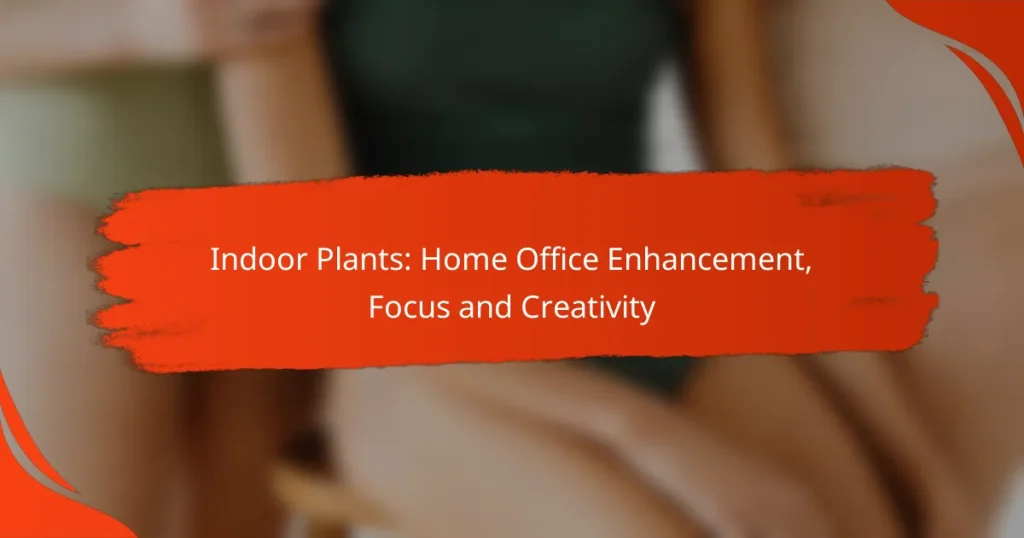Incorporating indoor plants into your home office can significantly enhance productivity by improving air quality and fostering a calming atmosphere. These green companions not only boost focus and creativity but also help reduce stress levels, creating an ideal environment for work. Selecting the right low-maintenance plants and understanding their care requirements can further elevate your workspace experience.
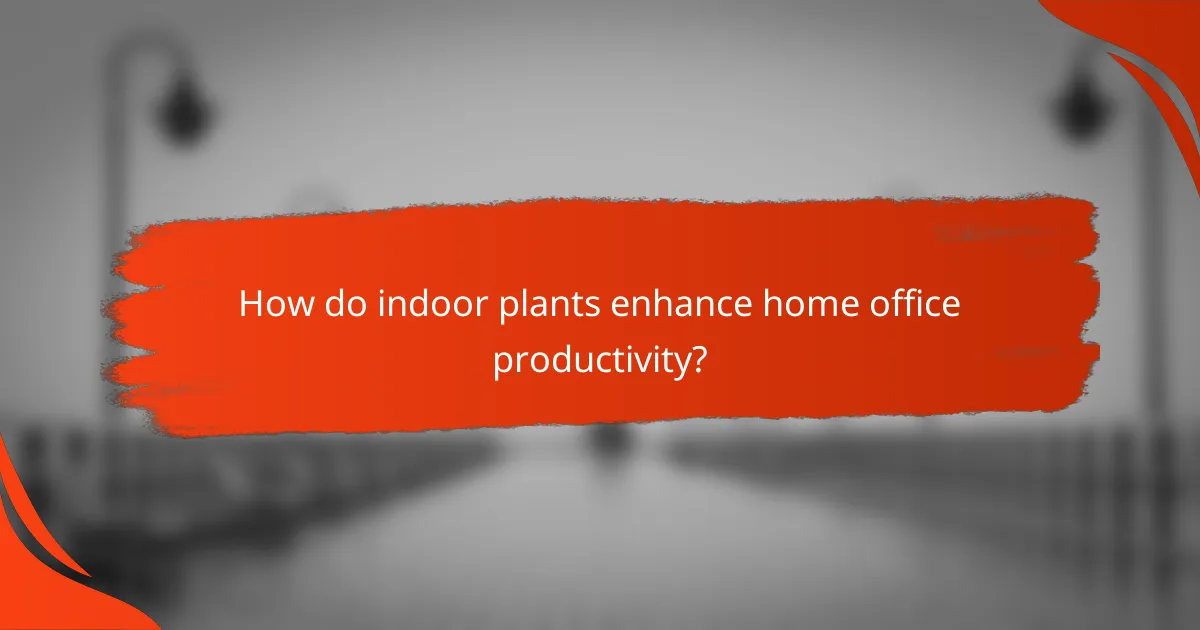
How do indoor plants enhance home office productivity?
Indoor plants enhance home office productivity by improving air quality, increasing focus, boosting creativity, and reducing stress levels. These benefits create a more conducive work environment, leading to better performance and overall well-being.
Improved air quality
Indoor plants can significantly improve air quality by absorbing carbon dioxide and releasing oxygen. They also filter out common indoor pollutants, such as formaldehyde and benzene, which can be found in office supplies and furniture.
Plants like the peace lily and snake plant are particularly effective at purifying air. Keeping a few of these plants in your workspace can lead to a fresher atmosphere, which is essential for maintaining energy levels throughout the day.
Increased focus
Having indoor plants in your home office can lead to increased focus and concentration. Studies suggest that the presence of greenery can enhance attention span and cognitive function, allowing you to work more efficiently.
To maximize focus, consider placing plants within your line of sight. A small desk plant, such as a succulent or a pothos, can serve as a visual anchor, helping to reduce distractions and keep your mind on task.
Boosted creativity
Indoor plants can also boost creativity by providing a calming and inspiring environment. The presence of nature has been linked to enhanced problem-solving skills and innovative thinking.
Incorporating a variety of plants can stimulate your senses and encourage creative ideas. For instance, a vibrant flowering plant or a unique terrarium can serve as a source of inspiration during brainstorming sessions.
Reduced stress levels
Having plants in your workspace can help reduce stress levels, promoting a sense of calm and relaxation. Studies have shown that interacting with plants can lower cortisol levels, which is associated with stress.
To create a stress-reducing environment, choose plants that require minimal maintenance, such as a ZZ plant or a spider plant. This way, you can enjoy their benefits without the added pressure of extensive care routines.
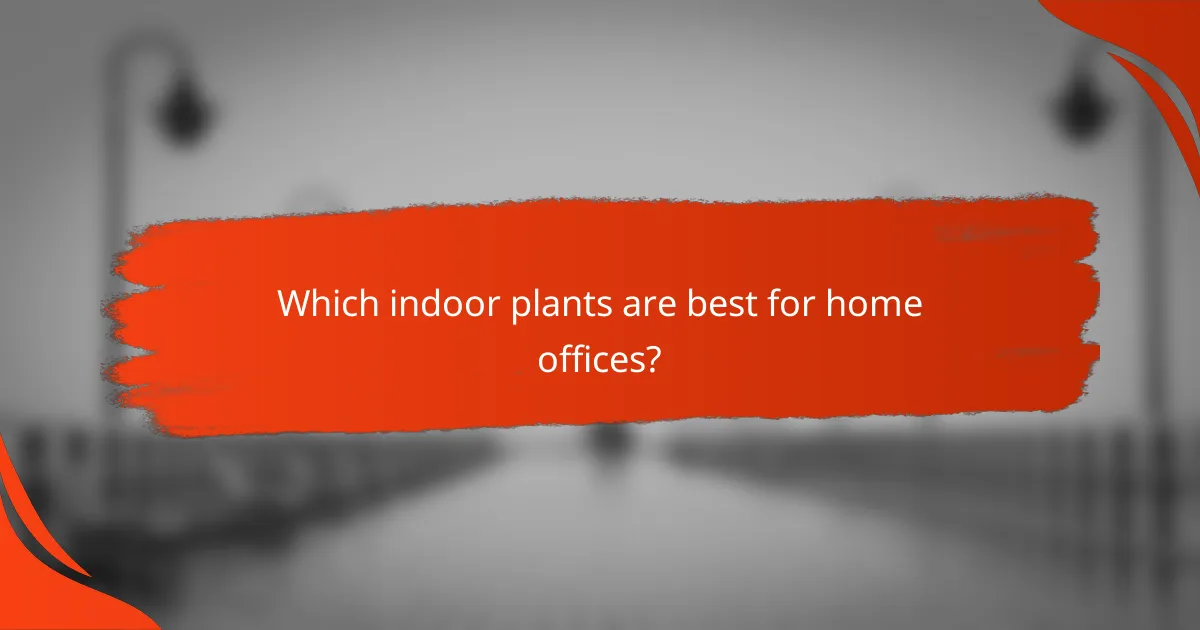
Which indoor plants are best for home offices?
Several indoor plants can significantly enhance your home office environment by improving air quality and boosting focus and creativity. Popular choices include low-maintenance varieties that thrive in indoor conditions and contribute to a calming atmosphere.
Snake plant (Sansevieria)
The snake plant is an excellent choice for home offices due to its air-purifying qualities and resilience. It can tolerate low light and infrequent watering, making it ideal for busy professionals.
This plant converts carbon dioxide into oxygen at night, which can help improve air quality while you work. Place it in a well-drained pot and water it sparingly to keep it healthy.
Pothos (Epipremnum aureum)
Pothos is known for its trailing vines and adaptability, making it a popular indoor plant for enhancing office spaces. It thrives in various lighting conditions, from low light to bright indirect light.
This plant is also effective at filtering indoor air pollutants. Regularly trim the vines to encourage bushier growth and ensure it receives adequate light for optimal health.
Peace lily (Spathiphyllum)
The peace lily is appreciated for its elegant white blooms and ability to thrive in low-light conditions. It is particularly effective at removing toxins from the air, which can create a healthier workspace.
Keep the soil moist but not soggy, and place it in a spot with indirect sunlight. Be cautious, as peace lilies are mildly toxic if ingested, so keep them out of reach of pets and children.
Spider plant (Chlorophytum comosum)
The spider plant is a hardy and easy-to-care-for option that can enhance your home office with its attractive foliage. It is known for its ability to purify the air and is safe for pets.
Spider plants thrive in bright, indirect light and prefer to dry out slightly between waterings. They also produce “baby” plants that can be propagated, allowing you to expand your indoor garden easily.

What are the care requirements for indoor plants?
Indoor plants require specific care to thrive, including appropriate light, watering, and soil conditions. Understanding these requirements can enhance their growth and contribute positively to your home office environment.
Light conditions
Light conditions are crucial for indoor plants, as they directly affect photosynthesis and overall health. Most indoor plants prefer bright, indirect light, while some can tolerate low light. It’s essential to assess the natural light available in your office space and choose plants accordingly.
For instance, succulents and cacti thrive in bright light, while snake plants and pothos can adapt to lower light levels. Consider rotating your plants periodically to ensure even light exposure and prevent leaning towards the light source.
Watering frequency
Watering frequency varies based on the type of plant, its size, and the environmental conditions. Generally, it’s better to underwater than overwater, as excess moisture can lead to root rot. A good rule of thumb is to check the top inch of soil; if it feels dry, it’s time to water.
Most indoor plants benefit from watering every 1-2 weeks, but this can change with seasonal variations. During warmer months, plants may require more frequent watering, while in cooler months, they may need less. Always ensure pots have drainage holes to prevent water accumulation.
Soil type
The right soil type is essential for indoor plants, as it affects drainage, aeration, and nutrient availability. A well-draining potting mix is typically recommended, which can be purchased or made by combining potting soil with perlite or sand.
Different plants may have specific soil needs; for example, orchids require a bark-based mix, while tropical plants often thrive in a moisture-retaining mix. Regularly check the soil’s condition and refresh it every couple of years to maintain optimal growth conditions.
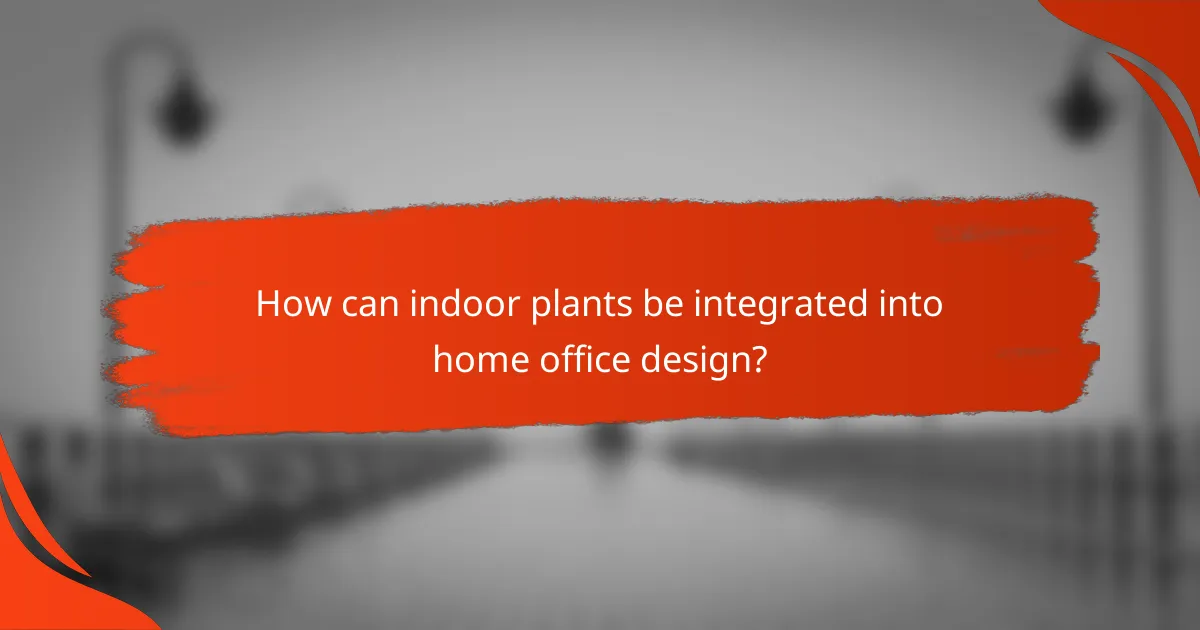
How can indoor plants be integrated into home office design?
Integrating indoor plants into home office design enhances aesthetics and boosts focus and creativity. By strategically placing plants, you can create a more inviting and productive workspace.
Desk placement
Placing plants directly on your desk can improve air quality and create a calming atmosphere. Choose smaller varieties like succulents or peace lilies that require minimal maintenance and fit well in limited space.
Ensure that the plants receive adequate light without obstructing your work area. A good rule of thumb is to keep plants within arm’s reach for easy care and to enjoy their benefits throughout the day.
Vertical gardens
Vertical gardens are a creative way to maximize space and add greenery to your home office. These installations can be wall-mounted and can feature a variety of plants, from ferns to herbs, depending on your light conditions.
Consider using modular systems that allow for easy rearrangement and maintenance. This approach not only saves floor space but also creates a striking visual impact that can inspire creativity.
Plant shelves
Incorporating shelves specifically for plants can enhance your office’s decor while providing a dedicated space for greenery. Use floating shelves or bookcases to display a mix of plant sizes and types, creating visual interest.
When arranging plants on shelves, group them by their light and water needs to simplify care. Ensure that taller plants are placed at the back and shorter ones in front to allow for visibility and access.
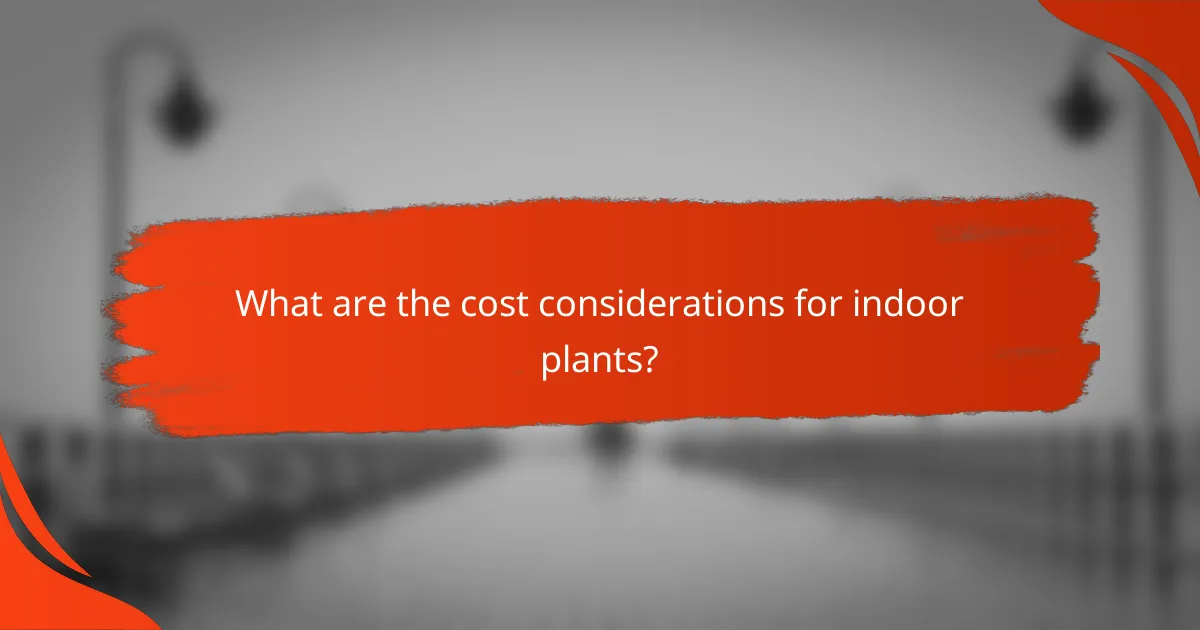
What are the cost considerations for indoor plants?
When considering indoor plants for your home office, cost factors include initial purchase prices and ongoing maintenance expenses. Understanding these costs can help you budget effectively and choose plants that enhance your workspace without breaking the bank.
Initial purchase costs
The initial purchase costs for indoor plants can vary widely depending on the type and size of the plant. Small, common varieties may cost as little as $10 to $30, while larger or more exotic plants can range from $50 to several hundred dollars. Consider shopping at local nurseries or online retailers to compare prices and find the best deals.
Additionally, factor in the cost of pots and soil, which can add another $10 to $50 to your initial investment. Choosing self-watering pots or decorative planters may increase your upfront costs but can enhance the aesthetic appeal of your office.
Ongoing maintenance expenses
Ongoing maintenance expenses for indoor plants typically include water, fertilizer, and occasional repotting. Monthly costs can be minimal, often under $10, especially if you choose low-maintenance plants that require less frequent care. However, more demanding species may require specific fertilizers and regular attention, increasing costs.
Don’t forget to consider potential replacements if a plant doesn’t thrive. Setting aside a small budget for plant care supplies and replacements can help you maintain a vibrant indoor garden without unexpected financial strain.
